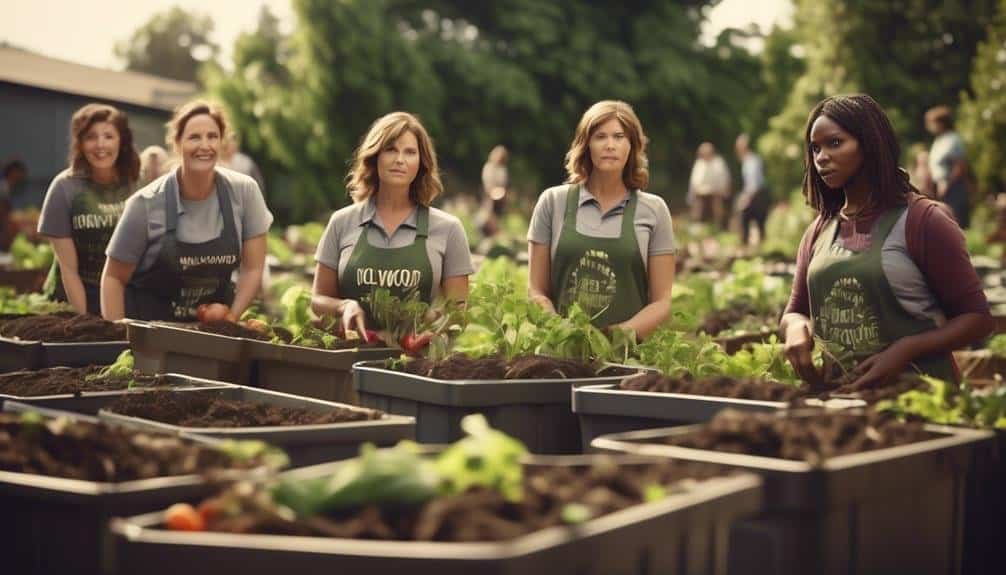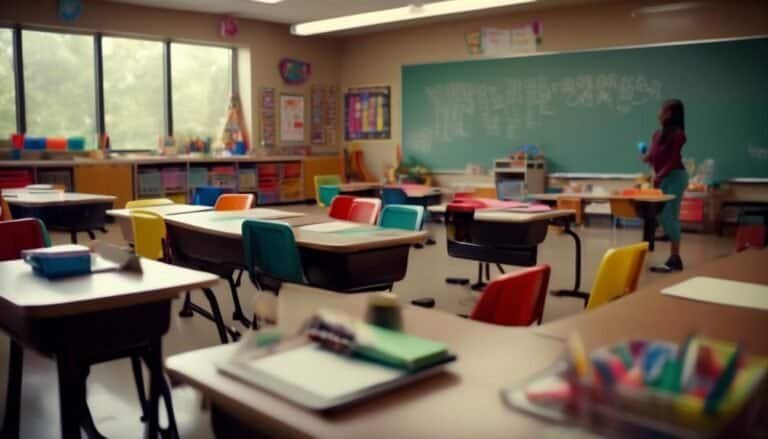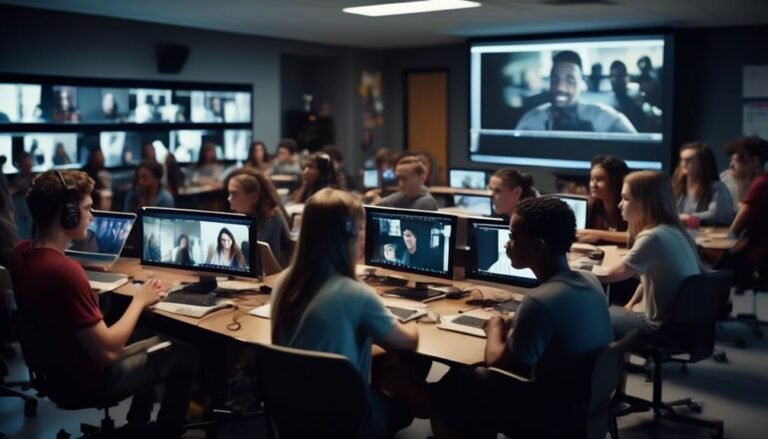Sustainability in Education: Teachers as Eco-Leaders
Imagine a world where the seeds of sustainability are planted within the minds of our future generations, where students not only learn about environmental responsibility, but also actively participate in creating a greener and more sustainable future. In this ever-changing landscape, teachers hold the key to nurturing these eco-leaders, guiding them towards a path of sustainable practices and inspiring them to become the change they wish to see in the world.
But how can teachers truly fulfill this crucial role? How can they become the eco-leaders our planet desperately needs? Embark on a journey with us as we explore the transformative power of sustainability in education and uncover the ways in which teachers can pave the way towards a more sustainable future.
Key Takeaways
- Teachers play a crucial role in shaping young minds and cultivating a sense of responsibility towards the environment.
- Incorporating environmental education into the curriculum helps students understand the interconnectedness between human actions and the natural world.
- Green classroom initiatives, such as designing the classroom space in an environmentally conscious way and implementing recycling programs, contribute to a sustainable learning environment.
- Sustainable teaching strategies, such as using sustainable resources in teaching materials and promoting the importance of sustainable practices, inspire students to embrace a greener way of living.
The Role of Teachers in Sustainability
Teachers play a vital role in promoting sustainability, serving as eco-leaders who inspire and empower students to become environmentally conscious global citizens. The role of educators in sustainability is crucial as they have the opportunity to shape young minds and cultivate a sense of responsibility towards the environment.
By incorporating environmental education into their curriculum, teachers can help students develop a deeper understanding of the interconnectedness between human actions and the natural world. Environmental education allows students to explore topics such as climate change, waste management, and conservation.
Through hands-on activities, field trips, and interactive discussions, teachers can engage students in practical experiences that foster a sense of environmental stewardship. By highlighting real-world examples and connecting them to local contexts, educators can show students how their actions can create positive change.
Furthermore, teachers can act as role models by practicing sustainable behaviors in their own lives. By demonstrating actions such as recycling, conserving energy, and reducing waste, educators can instill values of sustainability in their students. Additionally, teachers can encourage students to take part in sustainability initiatives within the school and the wider community, fostering a sense of collective responsibility.
Ultimately, the role of teachers in sustainability goes beyond imparting knowledge; they have the power to inspire and empower the next generation to become active participants in creating a more sustainable future.
Integrating Eco-Friendly Practices in the Classroom
Ready to transform your classroom into an eco-friendly haven?
Implementing green classroom initiatives, such as recycling programs and energy-saving practices, can make a big impact on sustainability.
By incorporating sustainable teaching strategies and integrating eco-conscious curriculum, you can empower your students to become environmentally responsible citizens.
Let's take action and create a greener future, one classroom at a time.
Green Classroom Initiatives
Creating a sustainable classroom starts with embracing eco-friendly practices and integrating them into every aspect of your teaching. One of the key elements of a green classroom initiative is designing the space in an environmentally conscious way. Consider using natural light, energy-efficient appliances, and eco-friendly materials for furniture and flooring.
Another important aspect is to stock up on eco-friendly school supplies. Look for products made from recycled materials, such as pencils, notebooks, and art supplies. Encourage students to reuse and recycle whenever possible.
Sustainable Teaching Strategies
To cultivate a sustainable classroom, integrate eco-friendly practices into your teaching, inspiring students to embrace a greener way of living.
Engaging activities can be a great way to promote sustainability in the classroom. For example, you can create hands-on projects that involve recycling, composting or reducing waste. Encourage students to actively participate in these activities and discuss the importance of sustainable practices.
Additionally, make use of sustainable resources in your teaching materials. Instead of printing out worksheets, consider using online platforms or digital resources to reduce paper waste. Encourage students to bring reusable water bottles and lunch containers to minimize single-use plastics.
Eco-Conscious Curriculum Integration
Now that you have implemented sustainable teaching strategies, it's time to take it a step further by integrating eco-friendly practices into your curriculum, allowing your students to actively engage with and learn about environmental conservation.
One way to do this is by developing sustainable lesson plans that incorporate eco-conscious teaching methods. Start by identifying areas in your curriculum where you can introduce topics related to sustainability and the environment. For example, in a science class, you can explore the impact of human activities on ecosystems and discuss solutions for conservation.
In a language arts class, you can incorporate literature that focuses on environmental issues and encourage students to write persuasive essays advocating for sustainable practices. By integrating these topics into your curriculum, you aren't only fostering a deeper understanding of environmental conservation but also empowering your students to become eco-conscious individuals who can make a positive impact on the world.
Fostering Environmental Awareness and Responsibility
Teachers play a pivotal role in cultivating a culture of environmental consciousness and accountability among students. By incorporating environmental education into their curriculum and promoting sustainable practices within schools, teachers can foster environmental awareness and responsibility in their students.
Environmental education encompasses a wide range of topics, including conservation, renewable resources, and climate change. Teachers can integrate these concepts into various subjects, such as science, social studies, and even art. By incorporating hands-on activities, field trips, and interactive projects, educators can make learning about the environment engaging and memorable.
In addition to integrating environmental education into their lessons, teachers can also promote sustainable practices within schools. This can include implementing recycling programs, reducing energy consumption, and encouraging students to bring reusable water bottles and lunch containers. By modeling these behaviors themselves, teachers can inspire their students to be more environmentally conscious.
Furthermore, teachers can empower their students to take action and make a positive impact on the environment. They can encourage students to participate in community clean-up events, join environmental clubs, or even start their own environmental initiatives. By providing opportunities for students to be active participants in environmental conservation, teachers can instill a sense of responsibility and agency in their students.
Creating Sustainable Learning Environments
Creating sustainable learning environments is essential for fostering a culture of environmental consciousness and responsibility among students. By implementing sustainable school design and using eco-friendly school supplies, educators can create spaces that inspire and educate students about the importance of sustainability.
Here are some ways you can create sustainable learning environments:
- Sustainable School Design:
- Incorporate natural lighting: Maximize the use of windows and skylights to reduce the need for artificial lighting and lower energy consumption.
- Utilize renewable energy sources: Install solar panels or wind turbines to generate clean energy for the school.
- Implement green spaces: Create gardens and outdoor learning areas that encourage students to connect with nature.
- Eco-Friendly School Supplies:
- Use recycled materials: Choose school supplies made from recycled materials, such as notebooks, pencils, and paper.
- Promote reusable items: Encourage students to bring reusable water bottles and lunch containers to reduce waste.
- Teach responsible consumption: Educate students about the environmental impact of their choices and promote mindful purchasing habits.
Collaborating With Students and Stakeholders for Change
To foster meaningful change and create a sustainable future, it's crucial for educators to collaborate with students and stakeholders. Collaboration with the community and engaging stakeholders are key elements in driving sustainable practices and initiatives within educational institutions. By involving students and stakeholders in decision-making processes, educators can ensure a more inclusive and effective approach to sustainability education.
Collaborating with the community allows educators to tap into local knowledge and resources that can enhance the learning experience. By working together with community members, educators can develop projects that address local sustainability challenges and provide students with real-world learning opportunities. This collaborative approach also fosters a sense of ownership and responsibility among students, as they become active participants in shaping their communities.
Engaging stakeholders, such as parents, school boards, and local businesses, is essential for creating a supportive environment for sustainability education. By involving stakeholders in the planning and implementation of sustainability initiatives, educators can ensure that these efforts align with the needs and values of the wider community. This collaboration also builds partnerships that can provide additional resources and support for sustainability education.
Empowering Students as Eco-Leaders
Are you ready to unleash the power of your students as eco-leaders?
By encouraging student-led sustainability initiatives, you can empower them to take ownership of creating a greener future.
Imagine the impact they can make through environmental awareness campaigns, spreading the message and inspiring others to join the cause.
By providing green leadership opportunities, you can nurture their passion, skills, and confidence to drive meaningful change in their schools and communities.
It's time to empower your students to become the eco-leaders that our planet needs.
Student-Led Sustainability Initiatives
How can you, as a student, become empowered as an eco-leader through student-led sustainability initiatives? By taking charge of your own sustainability campaigns and projects, you can make a real impact on your school and community. Here are some ways you can get started:
- Organize student-led campaigns: Rally your classmates and organize campaigns to raise awareness about pressing environmental issues. Whether it's promoting recycling, reducing plastic waste, or advocating for renewable energy, your voice and actions can make a difference.
- Implement sustainable projects: Take the initiative to implement sustainable projects in your school. This could include starting a composting program, creating a school garden, or organizing a clothing swap to reduce textile waste. By taking action and leading by example, you can inspire others to follow suit.
Environmental Awareness Campaigns
By harnessing the power of environmental awareness campaigns, you can truly become an eco-leader, making a lasting impact on your school and community.
One effective way to raise awareness is through environmental art installations. These installations not only serve as visual reminders of the importance of sustainability, but they also spark conversations and inspire action. Imagine a stunning sculpture made from recycled materials, or a mural depicting the beauty of nature. These installations can serve as powerful symbols that encourage people to rethink their relationship with the environment.
Another impactful initiative is promoting sustainable transportation. Encouraging your school to implement bike-sharing programs or organizing carpooling initiatives can significantly reduce carbon emissions and promote a greener way of commuting.
Green Leadership Opportunities
Empower students as eco-leaders by providing them with green leadership opportunities that allow them to make a meaningful impact on sustainability. By engaging students in green leadership programs, you can foster their environmental stewardship and encourage them to take charge of creating a greener future.
Here are some ways to empower students as eco-leaders:
- Create student-led sustainability clubs or organizations that focus on environmental initiatives such as recycling, energy conservation, or community gardens.
- Provide leadership roles for students in planning and implementing sustainable practices within the school, such as composting programs or reducing waste.
- Encourage students to participate in environmental competitions or challenges, where they can showcase their leadership skills and innovative ideas.
Conclusion
Congratulations, eco-leader! By integrating sustainability practices in your classroom, fostering environmental awareness, and creating sustainable learning environments, you're making a significant impact on the future.
Did you know that according to a recent study, schools that prioritize sustainability have seen a 20% increase in student engagement and academic performance?
Keep inspiring your students to become eco-leaders and together we can create a greener and more sustainable world.
Keep up the great work!







